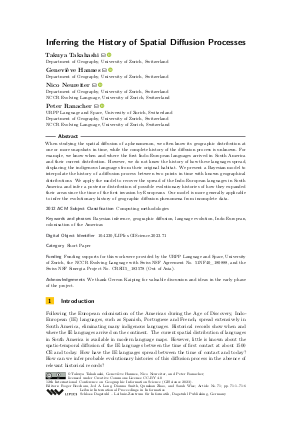Inferring the History of Spatial Diffusion Processes (Short Paper)
Authors
Takuya Takahashi  ,
Geneviève Hannes
,
Geneviève Hannes  ,
Nico Neureiter
,
Nico Neureiter  ,
Peter Ranacher
,
Peter Ranacher 
-
Part of:
Volume:
12th International Conference on Geographic Information Science (GIScience 2023)
Part of: Series: Leibniz International Proceedings in Informatics (LIPIcs)
Part of: Conference: International Conference on Geographic Information Science (GIScience) - License:
 Creative Commons Attribution 4.0 International license
Creative Commons Attribution 4.0 International license
- Publication Date: 2023-09-07
File

PDF
LIPIcs.GIScience.2023.71.pdf
- Filesize: 1.86 MB
- 6 pages
Document Identifiers
Subject Classification
ACM Subject Classification
- Computing methodologies
Keywords
- Bayesian inference
- geographic diffusion
- language evolution
- Indo-European
- colonisation of the Americas
Metrics
- Access Statistics
-
Total Accesses (updated on a weekly basis)
0PDF Downloads0Metadata Views
Abstract
When studying the spatial diffusion of a phenomenon, we often know its geographic distribution at one or more snapshots in time, while the complete history of the diffusion process is unknown. For example, we know when and where the first Indo-European languages arrived in South America and their current distribution. However, we do not know the history of how these languages spread, displacing the indigenous languages from their original habitat. We present a Bayesian model to interpolate the history of a diffusion process between two points in time with known geographical distributions. We apply the model to recover the spread of the Indo-European languages in South America and infer a posterior distribution of possible evolutionary histories of how they expanded their areas since the time of the first invasion by Europeans. Our model is more generally applicable to infer the evolutionary history of geographic diffusion phenomena from incomplete data.
Cite As Get BibTex
Takuya Takahashi, Geneviève Hannes, Nico Neureiter, and Peter Ranacher. Inferring the History of Spatial Diffusion Processes (Short Paper). In 12th International Conference on Geographic Information Science (GIScience 2023). Leibniz International Proceedings in Informatics (LIPIcs), Volume 277, pp. 71:1-71:6, Schloss Dagstuhl – Leibniz-Zentrum für Informatik (2023)
https://doi.org/10.4230/LIPIcs.GIScience.2023.71
BibTex
@InProceedings{takahashi_et_al:LIPIcs.GIScience.2023.71,
author = {Takahashi, Takuya and Hannes, Genevi\`{e}ve and Neureiter, Nico and Ranacher, Peter},
title = {{Inferring the History of Spatial Diffusion Processes}},
booktitle = {12th International Conference on Geographic Information Science (GIScience 2023)},
pages = {71:1--71:6},
series = {Leibniz International Proceedings in Informatics (LIPIcs)},
ISBN = {978-3-95977-288-4},
ISSN = {1868-8969},
year = {2023},
volume = {277},
editor = {Beecham, Roger and Long, Jed A. and Smith, Dianna and Zhao, Qunshan and Wise, Sarah},
publisher = {Schloss Dagstuhl -- Leibniz-Zentrum f{\"u}r Informatik},
address = {Dagstuhl, Germany},
URL = {https://drops.dagstuhl.de/entities/document/10.4230/LIPIcs.GIScience.2023.71},
URN = {urn:nbn:de:0030-drops-189662},
doi = {10.4230/LIPIcs.GIScience.2023.71},
annote = {Keywords: Bayesian inference, geographic diffusion, language evolution, Indo-European, colonisation of the Americas}
}
Author Details
- Department of Geography, University of Zurich, Switzerland
- NCCR Evolving Language, University of Zurich, Switzerland
Funding
Funding supports for this work were provided by the URPP Language and Space, University of Zurich, the NCCR Evolving Language with Swiss NSF Agreement No. 51NF40_180888, and the Swiss NSF Sinergia Project No. CRSII5_183578 (Out of Asia).
Acknowledgements
We thank Gereon Kaiping for valuable discussion and ideas in the early phase of the project.
References
-
Ronald E Asher and Christopher Moseley. Atlas of the world’s languages. Routledge, 2018.

- James Burridge. Spatial evolution of human dialects. Phys. Rev. X, 7:031008, July 2017. URL: https://doi.org/10.1103/PhysRevX.7.031008.
- James Burridge and Tamsin Blaxter. Using spatial patterns of english folk speech to infer the universality class of linguistic copying. Phys. Rev. Res., 2:043053, October 2020. URL: https://doi.org/10.1103/PhysRevResearch.2.043053.
- Lingling Sang, Chao Zhang, Jianyu Yang, Dehai Zhu, and Wenju Yun. Simulation of land use spatial pattern of towns and villages based on ca–markov model. Mathematical and Computer Modelling, 54(3):938-943, 2011. Mathematical and Computer Modeling in agriculture (CCTA 2010). URL: https://doi.org/10.1016/j.mcm.2010.11.019.
- Takuya Takahashi and Yasuo Ihara. Quantifying the spatial pattern of dialect words spreading from a central population. Journal of The Royal Society Interface, 17(168):20200335, 2020. URL: https://doi.org/10.1098/rsif.2020.0335.
- Takuya Takahashi and Yasuo Ihara. Application of a markovian ancestral model to the temporal and spatial dynamics of cultural evolution on a population network. Theoretical Population Biology, 143:14-29, 2022. URL: https://doi.org/10.1016/j.tpb.2021.10.003.
- Joe Yuichiro Wakano, William Gilpin, Seiji Kadowaki, Marcus W. Feldman, and Kenichi Aoki. Ecocultural range-expansion scenarios for the replacement or assimilation of neanderthals by modern humans. Theoretical Population Biology, 119:3-14, 2018. URL: https://doi.org/10.1016/j.tpb.2017.09.004.
